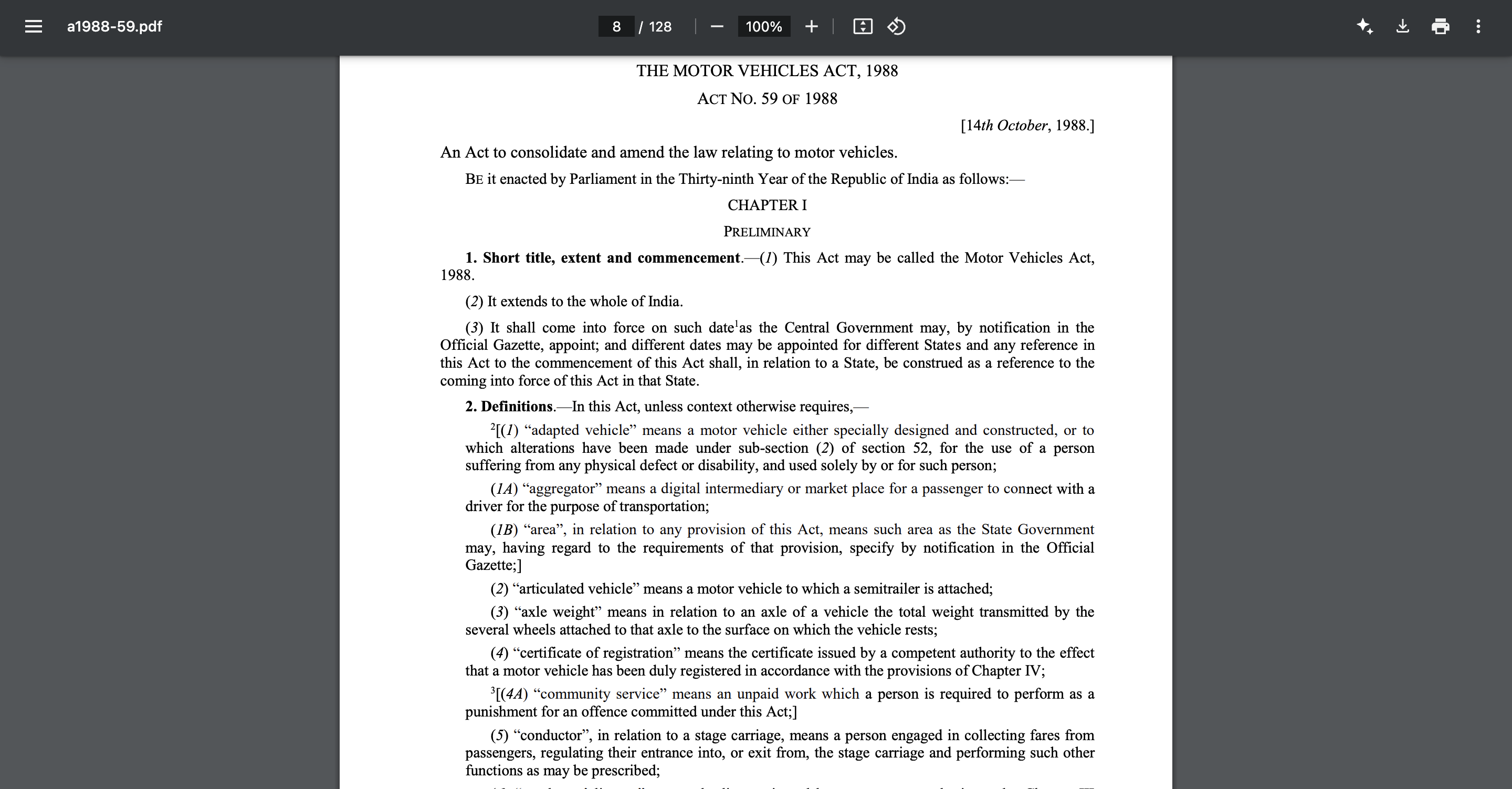BlaBlaCar at a Crossroads
Pivot, Reposition, or Shut Down?
- •BlaBlaCar, a leading long-distance carpooling platform, faces significant challenges in India as the government cracks down on non-commercial carpooling despite its potential to reduce traffic congestion.
- •While the law technically favors carpooling services like BlaBlaCar, legal cases can take years to resolve in court.
- •Political will currently sides with traditional cab unions, creating a challenging regulatory environment.
- •This case study explores strategic options for BlaBlaCar in India amid these regulatory pressures.

1. Identifying the Legal Roadblock
Key Legal Considerations
- §Carpooling is legal if there is no profit motive—just cost-sharing.
- §If the platform charges commission per ride, sets fares based on distance/time, or allows drivers to earn profits, it could violate Section 66(1) of the Motor Vehicles Act.
- §Two-wheelers are also included under the act.
What This Means For BlaBlaCar
- •Monetizing connections between carpoolers and co-riders can raise legal and political concerns.
- •To mitigate risks, the platform should avoid facilitating direct monetary transactions between users.
- •Revenue should not come from mediation between riders.
- •The platform should not position itself as a carpooling service that profits from connecting riders.
Thinking Next Step Out Loud
Our business model feels constrained, a pivot seems inevitable. As our primary strength is our large user base, we need to reconnect with our users to better understand their needs. This will help us determine whether a revenue model pivot is sufficient or if a deeper shift in our core value proposition is necessary to serve our existing audience effectively.
2. User Research & Market Insights
Ideally, I'd start with a hypothesis. However, since we're exploring a potential pivot, I want to keep be all ears. The objective of this initial research is:
- What problems users face with BlaBla.
- Their preferred modes of travel in different scenarios and the challenges they face.
- How (if at all) their lives would change if BlaBla ceased to exist.
Driver Personas
Amit
Profile
A young professional, student, or gig worker who owns a car but finds fuel and toll costs expensive. He frequently travels between cities and doesn't like driving alone.
Pain Points
- •
High fuel costs but doesn't want to drive alone
- •
BlaBlaCar feels like a dead app—people forget about it
- •
Difficult to find enough co-riders, leading to cancellations
- •
Usually gets one-person bookings and co-riders don't book because splitting into two is costly, forcing lower rates
- •
Lots of awkward silence during trips, questioning if traveling alone would be better due to different preferences in music and food stops
How BlaBlaCar Helps
- •
Lets him recover fuel expenses legally while providing companionship
- •
Offers a better alternative to solo long-distance driving
Opportunities
Create a more engaging app experience with regular notifications and incentives for consistent usage.
Co-Rider Personas
Vikram
Profile
A student, intern, or gig worker who travels between cities and needs an affordable option. He prefers BlaBlaCar over expensive taxis and last-minute train bookings.
Pain Points
- •
BlaBlaCar doesn't come to mind first—low recall
- •
Struggles to find available rides at the right time
- •
Public transport is unreliable, but BlaBlaCar feels inactive
How BlaBlaCar Helps
- •
Provides a cheaper and more comfortable alternative to public transport
- •
Offers flexible scheduling compared to fixed public transport options
Opportunities
Improve app visibility and recall through targeted marketing campaigns and push notifications for available rides.
Key User Research Datapoints
Travel Habits
- •Have to use multiple apps for daily intracity to occassional intercity travels.
- •Young users recall bike taxis companies before cab or carpooling companies.
- •Daily office commuters wish they could earn by bike sharing like a Rapido driver without the embarassment of having to wear a distinct company branded helmet.
- •Users have a lot of free time while co-riding or even as a carpool driver.
BlaBlaCar Painpoints
- •Hard to find riders/rides.
- •Female coriders almost never find a female driver or fellow co-rider.
- •Have to give in to driver's choice when comes to music, breaks and place to eat.
- •The trip feels awkward as mostly vibes dont match.
BlaBlaCar Benefits
- •Helpful In festive season when public transports are overbooked.
- •Travelling is not expensive.
- •Journey is comfortable in a private vehicle.
- •At times don't even have to pay half the cost of travel if the driver is looking to increase their rating.
SWOT Overview
- •Strength: Inter-city carpooling solves a strong though not frequent requirement of the userbase.
- •Weakness: Blabla is used as a last resort not as a choice. Also chances of finding a co-rider are low.
- •Opportunities: Social and emotional aspects of the product are valued by customers but largely unsolved.
- •Threats: If bike taxi services pivot to non-commercial carpooling with the right positioning, they may eat the BlaBla share due to better MAU and brand recall.
Thinking Next Step Out Loud
- •Erosion of Network Effects: Declining usage is weakening value proposition exponentially.
- •Brand Perception Decline: Lack of app updates and failure to find rides most of the times has diminished trust.
- •Untapped Social Opportunity: No current player has prioritized the social dynamics of ridesharing despite complaints across user personas.
- •Boosting MAU & Brand Recall: Low MAU led to low brand recall and eventually low usage, the pivot should focus on including aspects where customers visit the platform at least biweekly.
To explore a legally and financially viable pivot, I'll map our users' JTBDs based on recent research. I'll emphasise on Emotional and Social needs due to market gap and declining brand perception.
Jobs To Be Done (JTBDs) - Based on Prioritized Painpoints
Functional JTBD
- •I want to find a cab/bike immediately when I open the carpooling/ride hailing app standing outside to travel within my city so that I can reach my destination without delay.
- •I want to pre-schedule rides in advance so that I don't have to worry about last-minute availability when I need to travel at a fixed time.
- •I want to have a travel app that almost always gives cheapest fares while booking my ride so that I can instantly book my travel without having to compare multiple apps.
- •I want a UPI payment option during the journey so that I don't have to wait after the journey is over or scramble for cash.
- •I want to find more carpool rides having more people while travelling so that I can save more and go out without getting constrained by my budget.
- •I want to easily find ride requests along my usual route so that I can earn extra money without going out of my way.
- •I want a flexible system that lets me accept or reject rides without penalties so that I can drive only when it's convenient for me.
- •I want to be able to get a lift easily when I am in a bleak area so that I can move out of an unknown place without having hours for a cab to arrive.
Social JTBD
- •I want a good-looking bike and driver while travelling via bike taxi so that I don't feel embarrassed while traveling for business or social occasions.
- •I want to reduce my carbon footprint while travelling so that I can feel I do my bit towards a greener planet without having to pay more money than I would have.
- •I want to help stranded solo women travellers while I travel so that I can feel I helped a woman who would be facing the same safety concerns as my sister but by ensuring my actions are perceived as genuinely helpful rather than intrusive or unsettling.
- •I want to help stranded single passengers on my way so that I feel good when they thank me and compliment my premium bike.
- •I want to carpool with someone I can vibe with on my way back from work so that I can unwind and take my mind off office pressure without having to ride with colleagues.
Emotional JTBD
- •I want female drivers/co-riders while travelling so that I can feel relaxed and safe.
- •I want the app to take notice in case some irregularity in journey happens so that I can feel safe and assured that the company is taking care of me when I travel with them.
- •I want co-riders/drivers I can vibe with while travelling longer distances so that I can enjoy my journey without having to force conversations with someone I might never see again.
- •I want to ride with other professionals or verified users so that I can network or avoiding unsafe situations.
- •I want to see my driver's/biker's route and ETA accurately so that I can feel assured and plan my time better.
- •I want to be able to get a lift from someone I can trust when I am stuck in bleak areas so that I can move out of an unknown place to a more crowded area.
Insights from JTBD Themes
- •Users are now habituated to Uber, Ola, Rapido and expect same quality of services (not same services) from BlaBla.
- •Our userbase riders are very different from that of Ola, Uber so while they value money, the experience of journey is also equally important.
- •Our userbase co-riders expect BlaBla to have a differentiated experience than Ola, Uber because they expect the driver to be of similar socio-economic background.
Thinking Next Step Out Loud
The pivoted product should be such that losing carpooling rights should not mean the end of business for us.
If we get it right, I think focusing on social layer of travelling will give us a moat that will be difficult to beat.
Even in a long-term view, once the EVs become dominant in the market, I believe fare will go down and social experience will be a key differentiator.
Meanwhile lets also try to solve for the existing model by solving for declining bookings.
Pivot Hypothesis
I believe users are placing increasing value on the social experience with co-passengers, as much as the cost of travel. We should solve for the social aspect of travel.
3. Breaking Down Problems

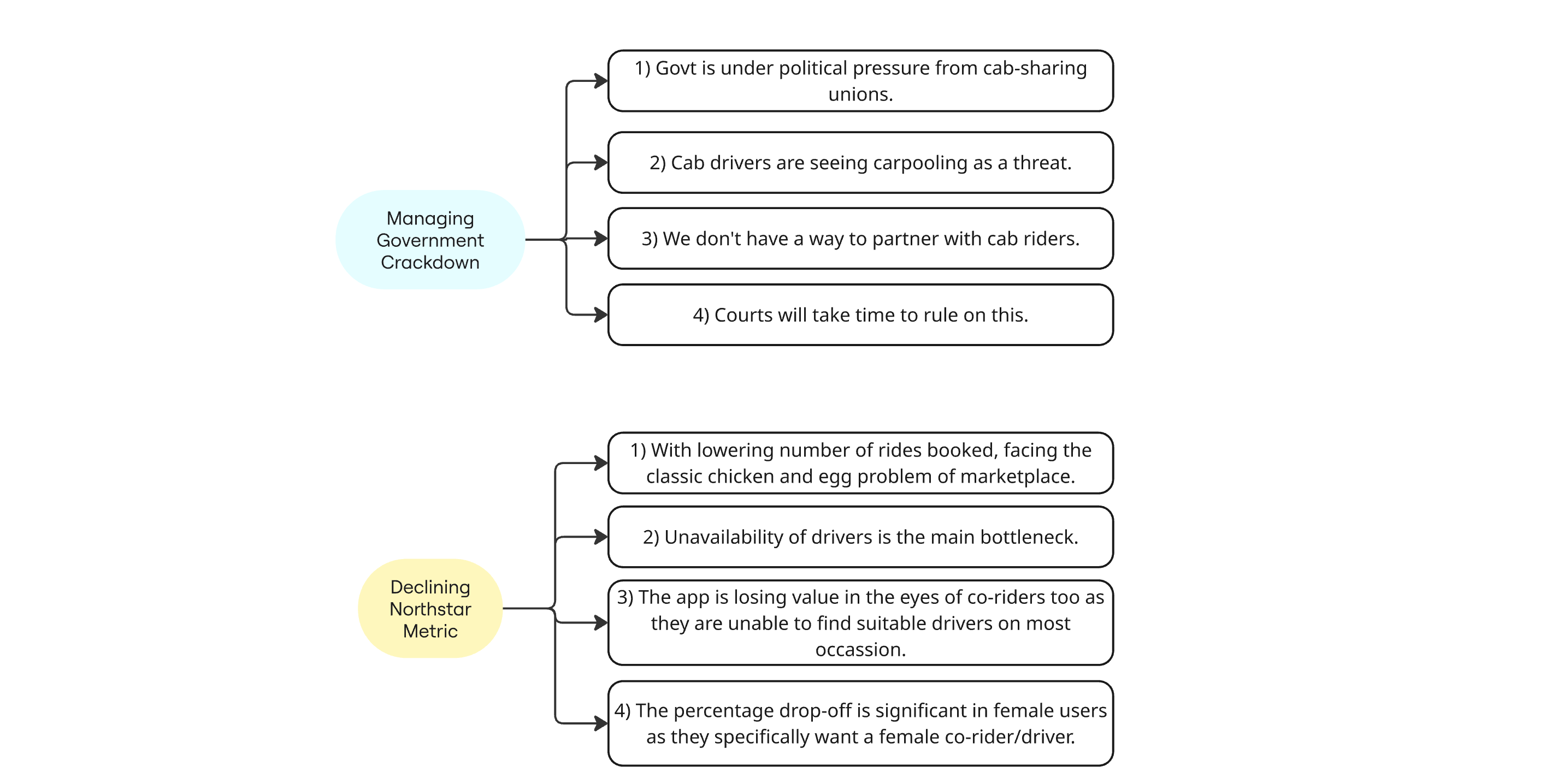
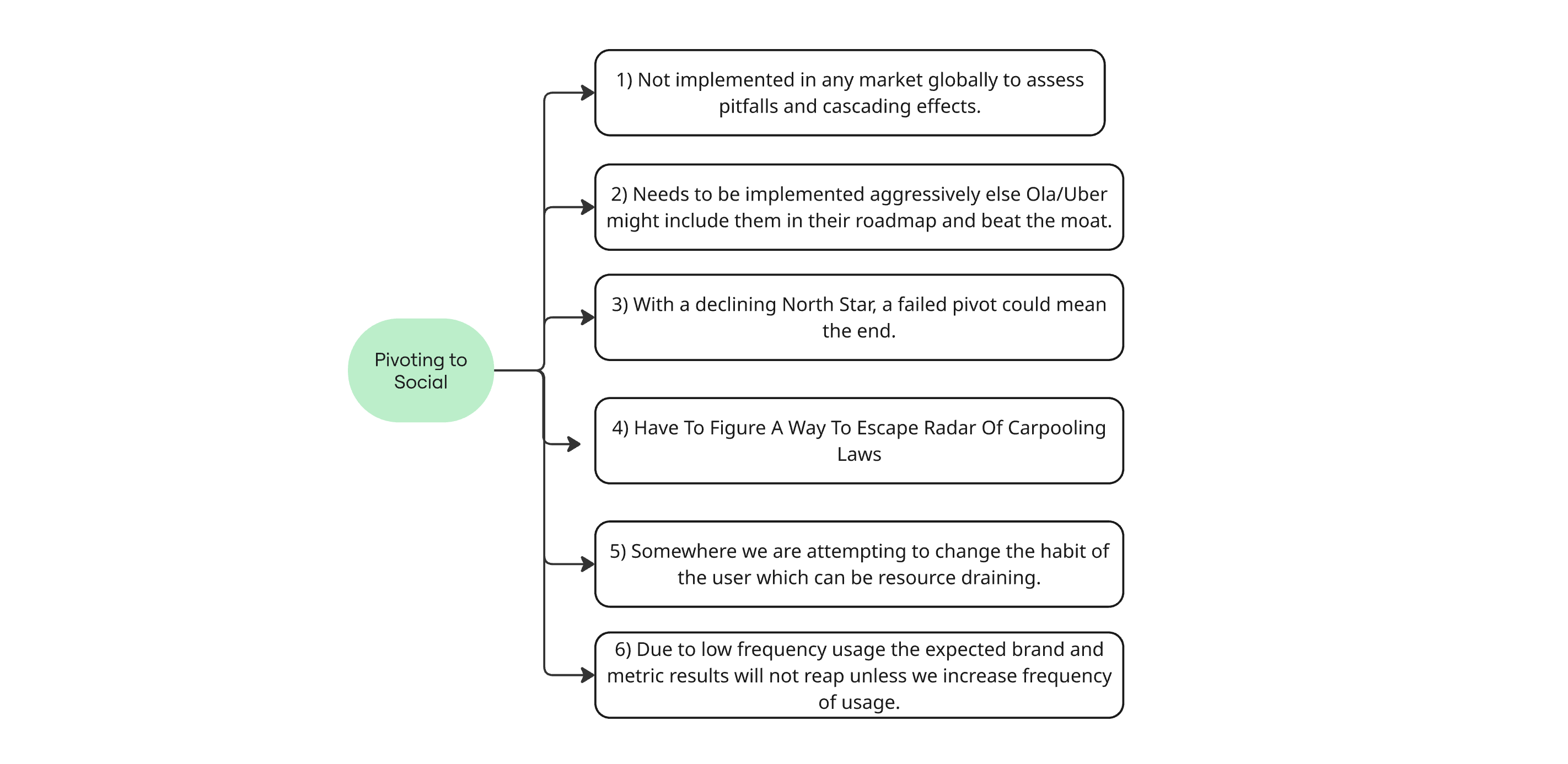
4. Solutioning
Now I will list problems, identify their root cause and write an approach to finding their solution, and then list the possible solutions.
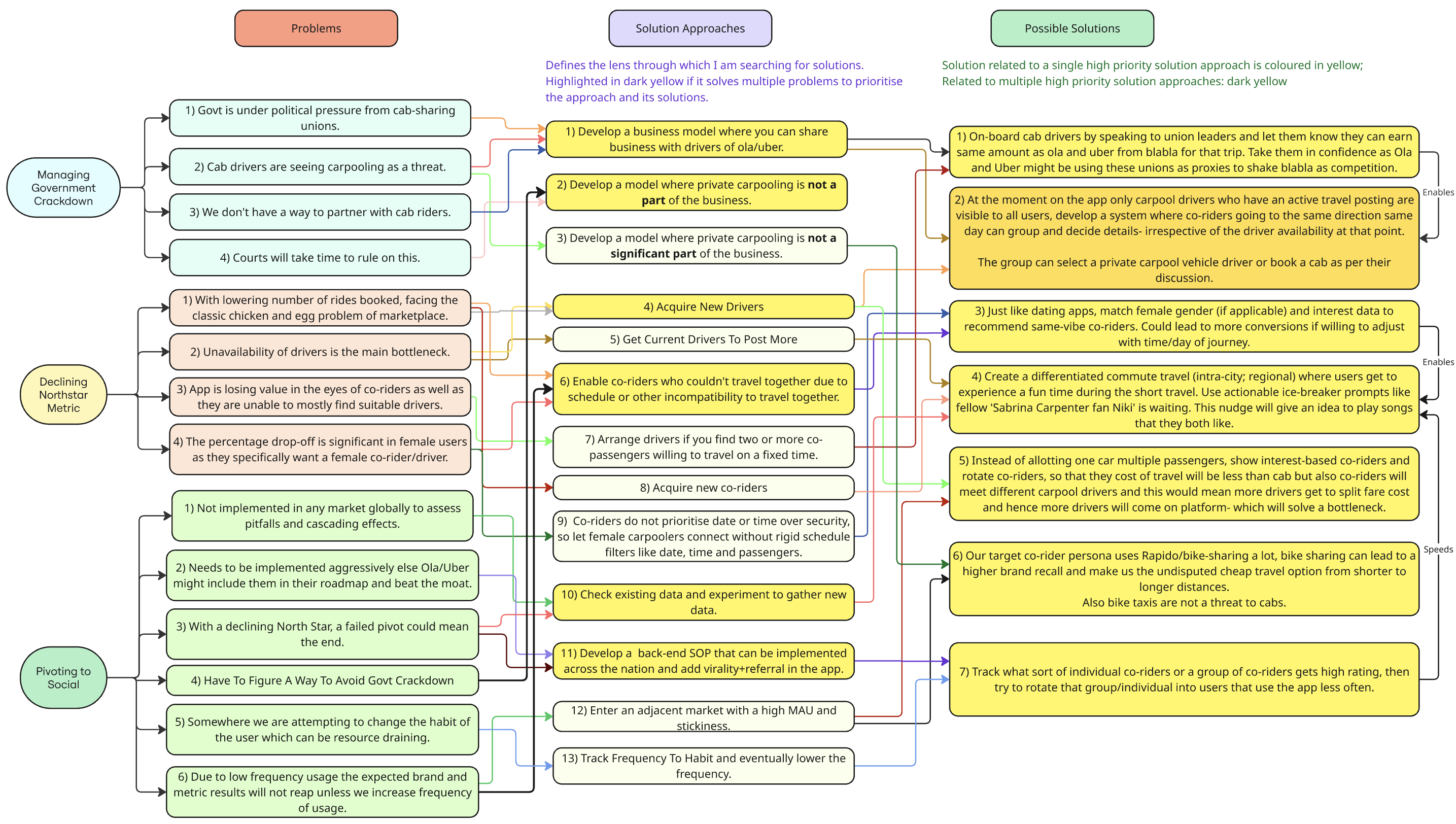
5. Data & Experimentation
I will validate our hypothesis of a social travel experience using existing data. Since existing user profiles already include bios, we can categorise users based on their interests and see how often people preferred traveling with those who share similar traits.
To reduce costs, I will narrow down the scope of analysis and see only if those who give more than 4 star ratings to each other on a trip happen to be of the same category or not:
- 1Find Users Who Have Given at Least Two Ratings of 4 or Higher
- 2Find Users Who Have Given at Least Two Ratings Below 4
- 3Filter Users Who Appear in Both Groups (ensuring they don't always give high ratings)
- 4Check If Users Who Rate Each Other Highly Belong to the Same Category
SQL Query for Analysis:
WITH HighRatings AS (
SELECT user_id, COUNT(*) AS high_rating_count
FROM rides
WHERE rating >= 4
GROUP BY user_id
HAVING COUNT(*) >= 2
),
LowRatings AS (
SELECT user_id, COUNT(*) AS low_rating_count
FROM rides
WHERE rating < 4
GROUP BY user_id
HAVING COUNT(*) >= 2
),
FilteredUsers AS (
SELECT h.user_id
FROM HighRatings h
JOIN LowRatings l ON h.user_id = l.user_id
),
MutualHighRatings AS (
SELECT r1.user_id AS user1, r1.driver_id AS user2
FROM rides r1
JOIN rides r2 ON r1.user_id = r2.driver_id AND r1.driver_id = r2.user_id
WHERE r1.rating >= 4 AND r2.rating >= 4
)
SELECT mh.user1, mh.user2, u1.category AS user1_category, u2.category AS user2_category,
CASE WHEN u1.category = u2.category THEN 'Same Category' ELSE 'Different Category' END AS category_match
FROM MutualHighRatings mh
JOIN users u1 ON mh.user1 = u1.user_id
JOIN users u2 ON mh.user2 = u2.user_id
WHERE mh.user1 IN (SELECT user_id FROM FilteredUsers)
AND mh.user2 IN (SELECT user_id FROM FilteredUsers);This query identifies users who rate each other highly and checks if they belong to the same interest category.
Feature Testing
PERSONALITY FEATURES ROLLOUT
What Is The Feature:
This feature allows riders and drivers to select personality tags that describe their travel style, conversation preferences, and interests.
Instead of randomly matching co-riders and drivers, we introduce tags to help co-riders find a travel vibe that suits them.
What We Are Testing:
- •Before the ride: Do riders actively select personality-based preferences or just skip them?
- •During ride search: Do riders show more interest (e.g., booking faster) when they see a personality match?
- •After the ride: Does post-ride behaviour change? (e.g., higher ratings, more repeat bookings, better reviews).
We will prompt drivers without a bio to select a tag from predefined categories (based on our pre-SQL data categorisation) and observe co-riders' choices.
Sample Tags:
These tags eliminate the need for Spotify API - which is an expensive integration. Since most of our user base uses YouTube Premium, this approach is more practical.
SOCIAL GROUPING ROLLOUT
What Is The Feature:
This feature allows riders to group with other unknown riders who are travelling to the same or nearby locations around the same day/time.
So even if there are no carpool drivers, the users can group and book a shared cab which will be cheaper than booking a cab alone. Also the group feature will have a referral that can be shared with friends or posted in a group- increasing user acquisition.
Why This Feature:
The key thought behind this feature is to reduce the drop-off cases when there are multiple co-riders who want to travel to the same location but drivers are not available.
It will disrupt intercity cab booking as it is cheaper because cab is carpooled.
What We Are Testing:
- •Adoption & Engagement: Do users join group rides instead of dropping off?
- •Ride Booking Behaviour: Does grouping lead to more successful ride completions in low-driver areas?
- •Social Matching Effectiveness: Does traveling with grouped co-riders improve user experience and retention?
- •Network Growth: Does the referral feature drive new user acquisition?
Need to onboard commercial cab drivers in these regions before rollout.
This test will be conducted only in areas where we are not facing regulatory threats. If successful, we can use this model to negotiate with affected regions for a smoother expansion.
6. Business Mapping
Current Business Canvas

Current Business Model Canvas showing BlaBlaCar's existing key partners, activities, propositions, customer relationships, and revenue streams.
Proposed New Business Canvas
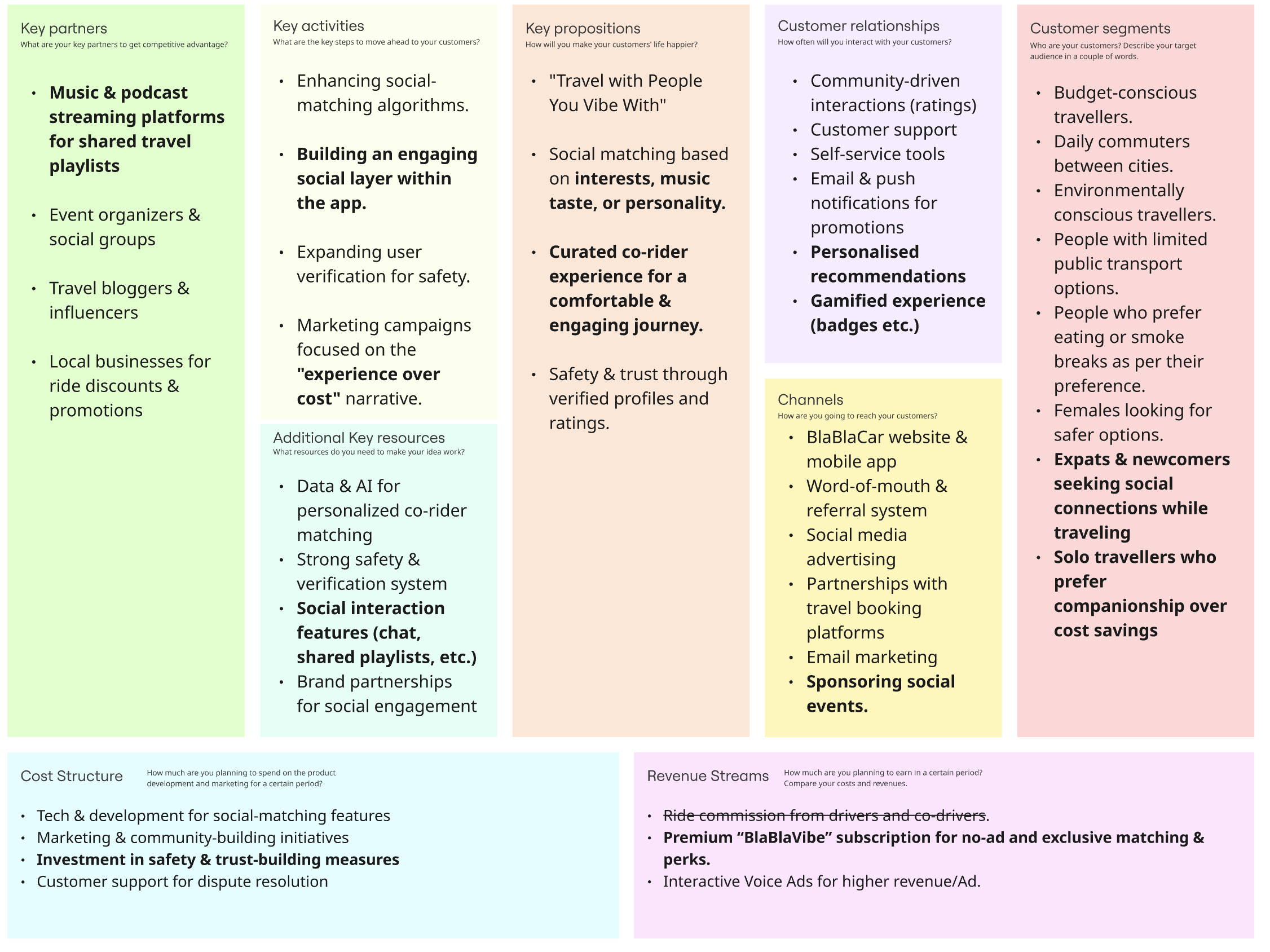
Proposed New Business Model Canvas with a pivot toward social connections and community building, featuring new revenue streams like "BlaBlAVibe" subscriptions and value propositions centered around matching users with similar interests, music taste, and personalities.
7. Brand Repositioning Strategy
Our brand repositioning strategy focuses on shifting from a pure carpooling platform to a social travel experience platform. This strategic pivot allows us to maintain our core value proposition while adapting to regulatory challenges and evolving user needs.
Key Strategic Initiatives
Travel Community Platform
Reposition as a 'Travel Community Platform' rather than a 'Carpooling Service' to navigate regulatory concerns while maintaining our core offering.
Social Connection Focus
Emphasize the social connection aspect of travel, highlighting the benefits of traveling with like-minded individuals.
Premium Subscription Model
Introduce subscription model for premium features that enhance the social experience without directly monetizing rides.
Corporate Partnerships
Develop strategic partnerships with corporate clients to create closed carpooling networks for employees.
EMPHASIS ON CLOSE-AREA CARPOOLS
With improved social data and a growing driver base, we will be by now positioned to disrupt the commercial carpooling industry. Ola and Uber take a significant commission from drivers, which presents an opportunity for us to offer two clear advantages to daily commuters:
Travel with people you genuinely connect with.
Pay less for carpooling to work.
Our advertising efforts should now target non-restricted cities to gain traction before broader expansion.
